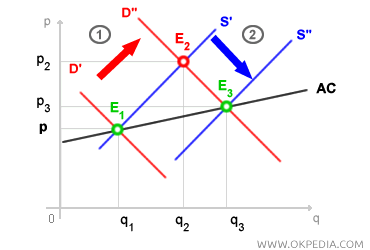Rising Cost Industry
A rising cost industry describes a type of long-run equilibrium where average costs increase as production output expands. When production rises, the average production costs also go up. This increase in average costs indirectly results in a higher selling price for the product. The concept of a rising cost industry can be illustrated on a graph, with production quantity on the x-axis and product price on the y-axis. In this scenario, the average cost curve (representing the long-run supply) slopes upward.

The initial market equilibrium occurs at point E1, where the short-run demand curve D' intersects with the short-run supply curve S'. A sudden surge in demand shifts the demand curve to the right (phase 1). The new equilibrium is established at the point where the adjusted demand curve D" meets the initial supply curve S'. However, this represents a temporary, short-term balance. In the long run, new competitor firms quickly enter the market. The temporary equilibrium at E2 results in an extra profit for the firms in the industry, calculated as the difference between the new market price (P2) and the average cost of production (AC - Average Cost). This profit attracts new firms, increasing the total supply. The supply curve S' shifts gradually to the right as long as this extra profit exists. This shift continues until it reaches equilibrium at point E3, where demand D" equals supply S" and the market price p3 aligns with the average costs (AC). Since the average costs are rising, the new equilibrium price p3 ends up higher than the initial price p1.
